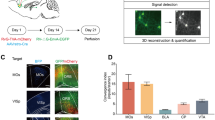Abstract
The claustrum is topographically and reciprocally connected with many different cortical areas, and anatomical and physiological data suggest it is composed of functionally distinct subdivisions. We asked if the distribution of cells immunoreactive for three calcium-binding proteins, parvalbumin, calbindin D-28k and calretinin would delineate functional subdivisions in the claustrum. We also asked if, as in cortex, different cell types were immunoreactive for the different proteins. We found that cells with parvalbumin-ir were large, multipolar cells. Cells immunoreactive for calretinin were bipolar cells with elongated cell bodies and beaded dendrites. There were three different types of cells immunoreactive for calbindin. The most numerous were small cells with round or oval cell bodies and numerous fine, winding processes. A second type were large multipolar, cells that resembled the parvalbumin-ir cells. The third class were bipolar cells with large, elongated cell bodies. Each type of cell resembles a cell type described in earlier Golgi studies, and each has a morphological cortical counterpart. While the different cell types varied in density, each was seen over the anterior-posterior and dorsal-ventral extent of the claustrum.
Similar content being viewed by others
Author information
Authors and Affiliations
Additional information
Accepted: 21 July 1998
Rights and permissions
About this article
Cite this article
Reynhout, K., Baizer, J. Immunoreactivity for calcium-binding proteins in the claustrum of the monkey. Anat Embryol 199, 75–83 (1999). https://doi.org/10.1007/s004290050211
Issue Date:
DOI: https://doi.org/10.1007/s004290050211




